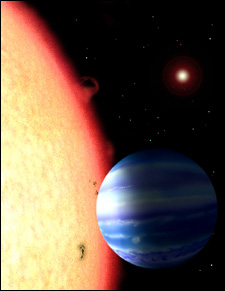New, far-out planet is discovered:
Would take 5,000 years to travel there at 186,000 mps

Astronomers have discovered a new planet in the constellation Sagittarius, the farthest from Earth found to date. It’s so distant that light takes 5,000 years to travel from there to here at a speed of 186,000 miles per second.
Unromantically called OGLE-TR-56b, the planet orbits too close to its sun to be hospitable to living things. Researchers estimate its surface temperature to be about 3,000 degrees F. In addition, it may be washed by rains of hot iron.
OGLE is just another of about 100 planets found outside our solar system, but the way that it was found could lead to the discovery of more planets like our lively Earth.
“We have found a better way to detect new worlds in our own Milky Way galaxy, which makes future planetary discoveries easier,” says Dimitar Sasselov, Thomas D. Cabot Associate Professor of Astronomy at the Harvard-Smithsonian Center for Astrophysics.
Astronomers can’t see such planets directly, even with the most powerful telescopes. They are too small compared with the stars they orbit, and they generate no light of their own. What light they reflect is lost in the glare of their mother star. All known planets beyond our solar system were initially detected by the wobbling, or other slight motions that their gravity produces as they orbit their stars. OGLE was spotted in a more direct way.
The new planet, some 115,000 miles in diameter, minutely dims the twinkle of its star when it passes between the star and light detectors on Earth. Sasselov compares it to solar eclipses seen when our moon passes between the sun and Earth. Of course, the dimensions involved are gargantuan by comparison. OGLE is 55 times as big as the moon, and its star, called OGLE-TR-56, lies 30 thousand trillion miles from our telescopes. Sasselov equates the feat to spotting a mosquito flying in front of a searchlight 200 miles away.
The dimming or transit technique is so sensitive, it should allow astronomers to spot planets as small as Earth that orbit in our Milky Way neighborhood. We are now, Sasselov notes, “at the leading edge of extrasolar planet research, and we are closer to finding other habitable worlds like our own.”
Ogling stars
Discovery of the huge Sagittarian planet resulted from a survey for which it is named, OGLE or Optical Gravitational Lensing Experiment. This survey ogles thousands of stars to detect changes in brightness caused by dark objects passing in front of their faces. OGLE-TR-56b was the program’s first success in its latest effort to search for planets beyond our solar system.
Sasselov and his team closely examined the dimming of 59 stars isolated from thousands in the survey. Using telescopes on mountain peaks in Arizona and Chile, the astronomers identified most of the candidates as star couples, or binaries, wherein a faint star orbits a brighter sister.
“Our success depended on efficiently eliminating binary stars using smaller telescopes,” explains Maciej Konacki, a researcher at the California Institute of Technology and a member of the discovery team. “The remaining planetary candidates were then confirmed using [light detectors mounted on] the largest optical telescope in the world, the 10-meter (33-foot) Keck I telescope in Hawaii.”
Future findings of planets by the eclipse – or transit – technique will not require such huge instruments. It should be what Konacki calls “a relatively easy and straightforward task.” The Keck telescope was needed only for the first confirmation that the drop in brightness was indeed caused by a planet and not something else.
The OGLE star and planet sit in an arm of the Milky Way that is next to the one where the sun and Earth are located. From above, our galaxy looks like a pinwheel with spiral arms spinning around its center. Sun and Earth sit in one of the outer edges, the Orion arm. The OGLEs lie in the next arm toward the galactic center.
The dimming that it causes when it passes in front of its star indicates that the new planet is about 1.3 times as big as Jupiter, at 88,700 miles in diameter the largest planet in our solar system. Coincidentally, astrologers believe that Sagittarius is ruled by Jupiter.
Jupiter orbits the sun at a mean distance of 500 million miles. OGLE sits a scant 2 million miles from its star, thus its searing temperatures. Mercury, another hot world, orbits 36 million miles from our star. A year on Mercury, one revolution around the sun, is 88 Earth-days long. The massive OGLE zips around its star so fast, its year occupies only 29 hours. OGLE, like Jupiter, is a massive ball of gas, not rock solid like Earth and Mercury.
A million-year dance
Stars shine by burning hydrogen fuel, leaving behind “ashes” of helium. Studies of starlight reveal stellar ages by comparing the wavelengths of light they emit to the ratio of fuel to ashes in various star models. OGLE’s age is about 4 billion years, close to the sun’s age of about 4.6 billion.
Sasselov and his colleagues believe that OGLE-TR-56b is about the same age as its star, as are the sun’s planets. Just after its birth, the researchers believe, OGLE was pulled toward its star by the attraction of gravity. The close encounter ripped a massive amount of gas away from the planet’s body. If the process had continued, the star would have devoured its planet.
However, after losing about half its mass, gravity exerted by a disk of gas and rock orbiting outside the planet exceeded the star’s pull. OGLE then spiraled away from the star and settled in its present orbit. According to the researchers, this “dance” between the star and its planet lasted for about a million years.
Lying so close to its star, the OGLE planet’s atmosphere should be hot enough to form clouds of iron droplets just as water droplets form clouds above Earth. That would lead to exotic showers of iron falling on OGLE-TR-56b, Sasselov and his colleagues speculate.
Discovery of the new planet will be described in the Jan. 23 issue of the journal Nature in a report written by Sasselov, Konacki, Guillermo Torres of the Harvard-Smithsonian Center for Astrophysics, and Saurabh Jha, a former Harvard graduate student. The authors note that searching for new planets by the transit method will be much more efficient than trying to find them by gravitational wobbling. Only giants like Jupiter and Neptune are big enough to make these wobbles visible, while transit passes should reveal worlds as small as Earth, orbiting at distances that could set the stage for sustaining life.
Also, astronomers expect the dimming method will allow them to examine many more stars – millions instead of thousands – in a shorter time. “Here at the Center for Astrophysics, we are currently conducting three more transit searches,” Sasselov points out.
Such ground-based surveys will soon be complemented by space-based investigations. The National Aeronautics and Space Administration plans to launch a mission in 2006 to check out thousands of stars during a four-year flight above the clouds and haze of Earth’s atmosphere. Named Kepler, for the German astronomer who discovered the laws of planetary motion, the mission will carry instruments sensitive enough to find Earth-size worlds. Current plans call for Kepler to be followed, between 2012 and 2015, by another mission to examine these places for signs of life.




